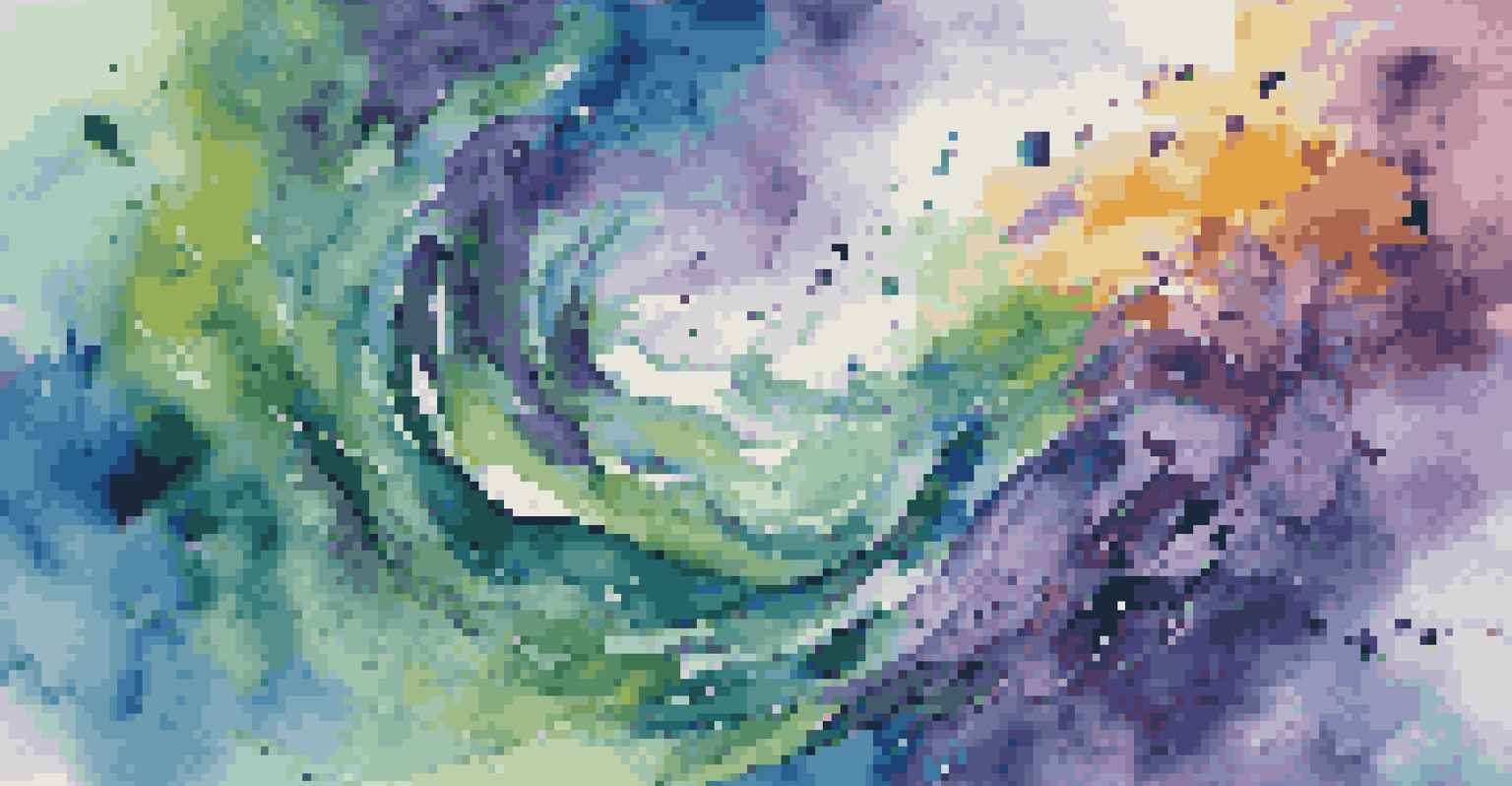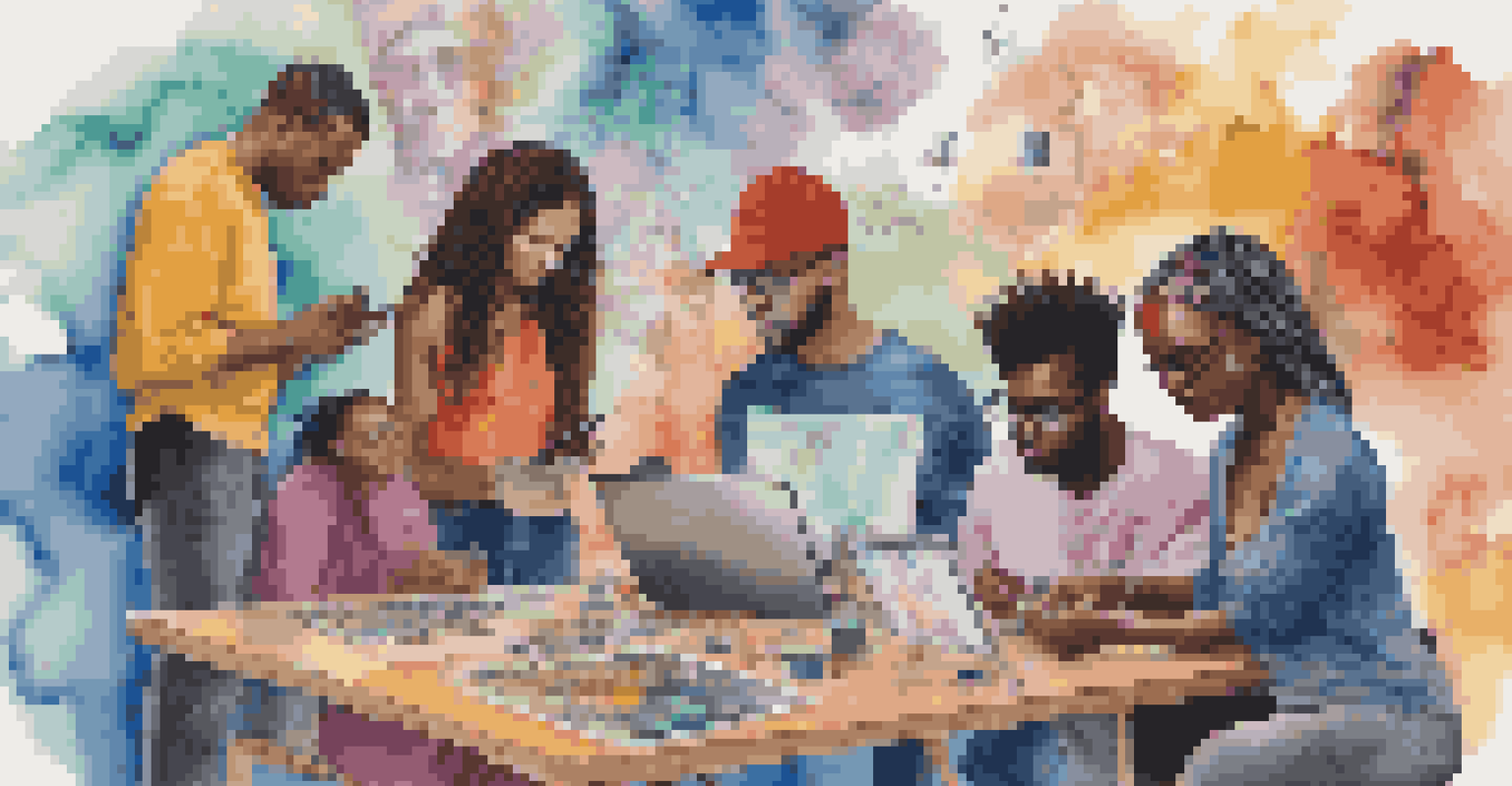Digital Art and Mental Health: Activism Through Creation

The Intersection of Digital Art and Mental Health
Digital art has emerged as a vibrant medium where creativity meets expression. Artists are increasingly using this platform to convey emotions and experiences related to mental health. This intersection not only showcases artistic talent but also sheds light on the often-stigmatized topic of mental illness.
Art is the most beautiful of all lies; it is the only way to tell the truth about life.
By transforming personal struggles into visual narratives, artists can foster understanding and empathy among viewers. For instance, a digital painting reflecting anxiety might resonate with those who experience similar feelings, creating a sense of community. This shared experience can validate emotions and encourage open conversations about mental health.
As technology continues to evolve, digital art becomes more accessible, allowing a wider audience to engage with these crucial themes. Social media platforms amplify this reach, enabling artists to connect with individuals globally, thereby creating a larger support network for mental health advocacy.
Art as a Form of Self-Expression and Healing
Creating art can be a therapeutic process, allowing individuals to express emotions that may be difficult to articulate. Digital art, in particular, provides a unique space where feelings of anxiety, depression, or trauma can be transformed into visual form. This act of creation often serves as a release, helping to alleviate the weight of mental health struggles.

Many artists find solace in the digital canvas, as it offers limitless possibilities for exploration and experimentation. This freedom can lead to profound personal insights, enabling artists to confront and process their emotions. For example, creating a digital collage can help someone visualize their journey through mental health challenges, making the experience less isolating.
Digital Art Enhances Mental Health Awareness
Digital art serves as a vital medium for expressing mental health struggles, fostering empathy and understanding among diverse audiences.
Moreover, sharing these creations can inspire others who may be facing similar battles. When artists open up about their experiences, they not only validate their own feelings but also create a safe space for others to share theirs. This cycle of expression and support is pivotal in the mental health community.
Digital Activism: Advocating for Change
Digital art serves as a powerful tool for activism, raising awareness about mental health issues. Artists can use their work to highlight systemic problems, advocate for policy changes, or promote mental health resources. By merging creativity with activism, they can reach and inspire a broader audience than traditional methods might allow.
The greatest healing therapy is friendship and love.
For instance, campaigns that utilize striking digital artwork can capture attention and provoke thought, encouraging viewers to reflect on their own mental health or the state of mental health services. This form of activism can lead to tangible change, such as increased funding for mental health programs or shifts in public perception regarding mental illness.
Moreover, the shareability of digital art amplifies its impact, as it can quickly circulate through social media channels. This allows for grassroots movements to gain momentum and engage individuals who might not have previously considered the importance of mental health advocacy.
Community Building Through Digital Platforms
The rise of digital art has fostered communities centered around mental health and creativity. Online platforms enable artists and advocates to connect, share stories, and collaborate on projects that promote mental wellness. These spaces often become havens for individuals seeking support and understanding.
For instance, forums or social media groups dedicated to mental health art can provide a sense of belonging. Members share their artwork, discuss their journeys, and offer encouragement to one another. This community aspect can be incredibly empowering, reminding individuals that they are not alone in their struggles.
Community Support Through Digital Platforms
Online communities centered around digital art provide safe spaces for individuals to share their experiences and support one another in their mental health journeys.
Furthermore, these digital communities can organize events, such as virtual art shows or workshops, that promote mental health awareness. By harnessing the collective creativity and passion of their members, these groups can create impactful experiences that resonate beyond the screen.
Bridging Gaps: Accessibility of Digital Art
One of the remarkable aspects of digital art is its accessibility. With just a smartphone or tablet, individuals can create and share their artwork, breaking down barriers that might exist in traditional art forms. This democratization of art empowers people from various backgrounds to express themselves without the need for expensive materials or formal training.
Additionally, online platforms provide opportunities for exposure, allowing artists to reach global audiences. This increased visibility can lead to collaborations, exhibitions, or even funding opportunities for mental health projects. As a result, aspiring artists and advocates can gain recognition and support for their important work.
Moreover, digital art can be particularly beneficial for individuals with disabilities, as it offers flexible options for creation. Adaptive technology ensures that everyone can engage with art-making, further expanding the diversity of voices and stories represented in the mental health narrative.
The Role of Social Media in Art and Advocacy
Social media plays a pivotal role in the intersection of digital art and mental health activism. Platforms like Instagram and TikTok allow artists to showcase their work and share their stories in real time. This immediacy can create powerful connections between creators and viewers, fostering a supportive environment for open discussions about mental health.
Furthermore, hashtags related to mental health and art can help users discover new content and communities. Movements like #ArtForMentalHealth or #MentalHealthAwareness encourage individuals to engage with artworks that resonate with their experiences, sparking conversations that may not have happened otherwise.
Future of Art as Therapy and Advocacy
As technology advances, digital art is expected to play a growing role in therapeutic practices and mental health advocacy, enhancing personal expression and community connections.
As artists share their journeys alongside their creations, they humanize the experience of mental illness, making it relatable and less stigmatized. This visibility can lead to greater acceptance and understanding, ultimately contributing to a more compassionate society.
Future Trends in Digital Art and Mental Health
Looking ahead, the relationship between digital art and mental health is poised to evolve further. As technology advances, new tools and platforms will likely emerge, offering even more innovative ways for individuals to express themselves. Virtual reality (VR) and augmented reality (AR) could provide immersive experiences that deepen the connection between art and mental health advocacy.
Additionally, there may be a growing emphasis on art therapy integrated with technology, allowing mental health professionals to leverage digital art as a therapeutic tool. This could open doors for more personalized and engaging treatment options, catering to the unique needs of each individual.

Ultimately, as awareness around mental health continues to grow, so too will the role of digital art in fostering connection, healing, and advocacy. The future holds exciting possibilities for artists and advocates alike, creating a vibrant tapestry of expression that champions mental health for all.